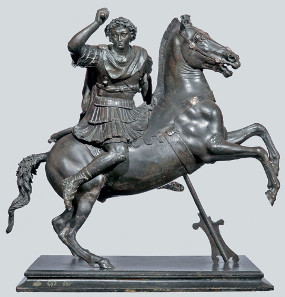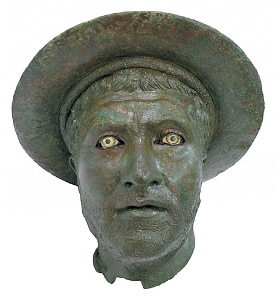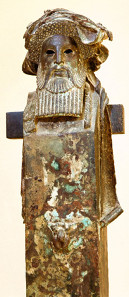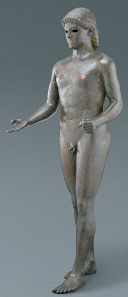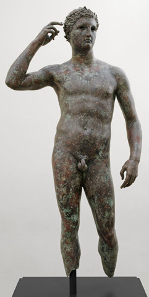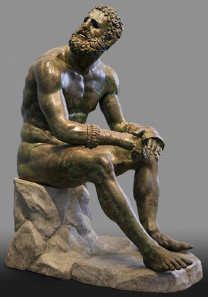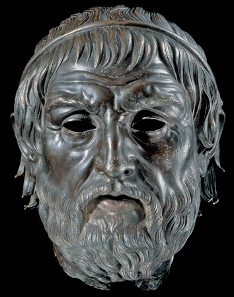October 15, 2015 – On view at the J. Paul Getty Museum from July 28 through November 1, 2015, “Power and Pathos: Bronze Sculpture of the Hellenistic World” is the first major international exhibition to bring together more than 50 ancient bronzes from the Mediterranean region and beyond ranging from the 4th century B.C. to the 1st century A.D. After the Getty, “Power and Pathos” will travel to the National Gallery of Art, Washington, D.C. December 13, 2015-March 20, 2016.
Alexander the Great on Horseback, 100-1 B.C. Su concessione Ministero dei Beni e delle Attività Culturali e del Turismo – Soprintendenza per i Beni Archeologici di Napoli – Photograph: Giorgio Albano.
Portrait of a Man, 300-200 B.C. Found in the Aegean Sea near Kalymnos. Photograph: Courtesy of the Hellenic Ministry of Culture, Education and Religious Affairs. The Archaeological Museum of Kalymnos.© Hellenic Ministry of Culture and Sports / Archaeological Receipts Fund.
Large-scale bronze sculptures are among the rarest survivors of antiquity; their valuable metal was typically melted and reused. Rows of empty pedestals still seen at many ancient sites are a stark testimony to the bygone ubiquity of bronze statuary in the Hellenistic era. Ironically, many bronzes known today still exist because they were once lost at sea, only to be recovered centuries later.
Left: Herm of Dionysos, 200-100 B.C., attributed to the Workshop of Boethos of Kalchedon. The J. Paul Getty Museum. Right: Herm from Mahdia. Signed by Boethos of Kalchedon. L’Institut National du Patrimoine de la Republique Tunisienne. Photograph: Werner Forman/Art Resource, NY.
“Power and Pathos: Bronze Sculpture of the Hellenistic World” is especially remarkable for bringing together rare works of art that are usually exhibited in isolation. When viewed in proximity to one another, the variety of styles and techniques employed by ancient sculptors is emphasized to greater effect, as are the varying functions and histories of the bronze sculptures. Bronze, cast in molds, was a material well-suited to reproduction, and the exhibition provides an unprecedented opportunity to see objects of the same type, and even from the same workshop together for the first time. For example, two herms of Dionysos – the Mahdia Herm from the Bardo National Museum, Tunisia and the Getty Herm were made in the same workshop and have not been shown together since antiquity.
Apollo, “The Piombino Apollo,” about 120-100 B.C. Musée du Louvre, Département des antiquités grecques, étrusques et romaines, Paris. Photograph: © RMN-Réunion des Musées Nationaux, Stéphane Maréchalle.
The exhibition is organized into six sections: Images of Rulers, Bodies Ideal and Extreme, Images of the Gods, The Art of Replication, Likeness and Expression, and Retrospective Styles.
Victorious Athlete, “The Getty Bronze,” 300-100 B.C. The J. Paul Getty Museum.
“Our aim in bringing together this extraordinary group of the most significant ancient bronzes that have survived is to present these works, normally viewed as isolated masterpieces, in their larger contexts,” said Kenneth Lapatin, the show’s co-curator. “These stunning sculptures come together to tell a rich story, not only of artistic accomplishment, but also of the political and cultural concerns of the people who commissioned, created, and viewed them more than two thousand years ago.”
Seated Boxer, “The Terme Boxer,” 300-200 B.C. Museo Nazionale Romano – Palazzo Massimo alle Terme. Su concessione del Ministero dei beni e delle attività culturali e del turismo – Soprintendenza Speciale per il Colosseo, il Museo Nazionale Romano e l’area archeologica di Roma. Photograph; © Vanni Archive / Art Resource, NY.
The iconic Terme Boxer on loan from the National Roman Museum, with its realistic scars and bruises, stands out as the epitome of the modern understanding of Hellenistic art, employing minute detail and an emphatic, arresting subject. The weary fighter, slumped and exhausted after his brutal competition, combines the power and pathos that is unique to Hellenistic sculpture.
Portrait of a Poet, “The Arundel Head”, 200-1 B.C. Photograph: Courtesy of and © The Trustees of the British Museum.
Timothy Potts, director of the J. Paul Getty Museum said: “At its best, Hellenistic sculpture leaves nothing to be desired or improved upon. The more than 50 works in the exhibition represent the finest of these spectacular and extremely rare works that survive, and makes this one of the most important exhibitions of ancient classical sculpture ever mounted. This is a must-see event for anyone with an interest in classical art or sculpture.”
This is the website of The Getty.
For having a look at the comprehensive publication accompanying the exhibition, please click here.
And more information about the 19th International Congress on Ancient Bronzes at the Getty in October is available here.





